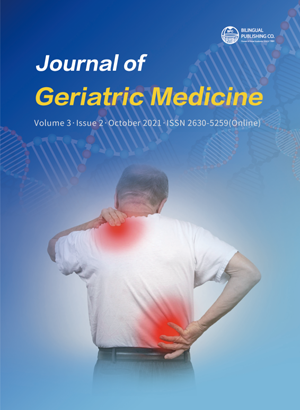 Correction & Withdrawal Policies
Correction & Withdrawal Policies
An Introduction of the Vaporized Therapy with Tea Herb Drink for Relieving Agitation due to Pulmonary Encephalopathy
DOI:
https://doi.org/10.30564/jgm.v3i2.3818Abstract
What methods would you choose apart from increasing sedatives foragitation in an advanced patient with hypercapnic encephalopathy dueto AECOPD? This is a 94-year-old female who suffered from COPD forover 30 years, occurred with an accelerated episode of cough, productivesputum and a dropping down to 86% in SatO₂ due to a cold weather. Adiagnosis of pulmonary encephalopathy (PE) was made on the basis of thesubsequent agitation and delirium, and the sedatives, such as quatiepineand haloperidol, had to be given for her mental excitation respectively, butshe still pulled out indwelling needle herself and refused to any infusiontherapy. As an alternative, a vaporized therapy integrated with tea herbdrinking had to be applied to relieving her agitation, being designedas the vaporization of the inhaled oxygenation by means of high-flowoxygenation device (HFOD), with an ampoule of ambroxol mixed into theinhaler and simultaneous drinking of TCM tea herb for reducing sputum,helping dissolve the mucoid bolts inside her terminal bronchioles whenbeing infected. We thought that a better efficacy would be achieved forhypercapnic encephalopathy due to AECOPD if we concentrate on a goodventilation of small airway through the vaporized therapy.Keywords:
Vaporized therapy, Tea herb drink, Pulmonary encephalopathy (PE) agitation, Mucoid bolts, Reducing sputumReferences
[1] Gupta H, Alrohimi A, Nathuo N, et al. (2020) Posterior reversible encephalopathy syndrome due to chronic obstructive pulmonary disease. Canadian journal of neurological sciences, 47: 569-571.
[2] Wang J, Cui Z, Liu S, et al.(2017) Early use of noninvasive techniques for clearing respiratory secretions during noninvasive positive-pressure ventilation in patients with acute exacerbation of chronic obstructive pulmonary disease and hypercapnic encephalopathy: A prospective cohort study. Medicine, 96: e6371.
[3] Paleari D, Rossi GA, Nicolini G, et al.(2011) Ambroxol: a multifaceted molecule with additional therapeutic potentials in respiratory disorders of childhood. Expert Opin Drug Discov, 6:1203-1214.
[4] Abiba.(1978) Effects of sublingual administration of Ephedra herba aqueous extracts on respiratory resistance in dogs. Annu Rep Tohoku Coll Pharm, 25: 23- 25.
[5] Wilcox N, Minton J.(2001) Role of antibody response in outcome of antibiotic associated diarrhea. Lancet, 357:158-159.
[6] Clift C, Salisbury DM.(2017) Enhancing the role of vaccines in combatting antimicrobial resistance. Vaccine, 35: 6591-6593.




 Jianbo Hong
Jianbo Hong





